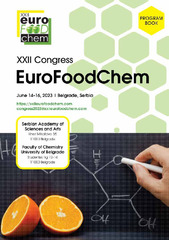Приказ основних података о документу
Experimental design and the desirability function in the estimation of overall food quality
| dc.creator | Lević, Steva M. | |
| dc.creator | Lučić, Milica | |
| dc.creator | Sredović Ignjatović, Ivana | |
| dc.creator | Onjia, Antonije | |
| dc.date.accessioned | 2023-12-28T10:35:07Z | |
| dc.date.available | 2023-12-28T10:35:07Z | |
| dc.date.issued | 2023 | |
| dc.identifier.isbn | 978-86-7132-083-2 | |
| dc.identifier.uri | http://TechnoRep.tmf.bg.ac.rs/handle/123456789/7055 | |
| dc.description.abstract | The overall quality of processed food depends on many processing parameters such as temperature, processing time, mixing speed, pressure, pH value, size of food pieces, type of added ingredients, etc. The goal of food products devel- opment is not only to improve the quality of the final product but also to reduce the energy consumption and to improve resources management. Independent evaluation of a single parameter or response is not the best way to set and optimize experiments, because improving one response by controlling one parameter can negatively affect other responses. Experi- mental design is frequently used for experiment planning when multiple variables should be optimized, while the desirability function allows the determination of operating conditions that provide the “most desirable” response values. The desirability function allows the optimization of several responses simultaneously and the determination of the overall/cumulative/global quality. In this way, it is possible to determine the most suitable conditions for achieving the best overall product quality. In the desirability function, all responses are transformed into dimensionless individual desirability functions (di), which take values from 0 to 1. The value 0 indicates an undesirable response of the system, while the value 1 represents the most de-sirable response. All values between 0 and 1 indicate more or less desirable responses. There are three different equations for evaluating individual desirability functions depending on whether it is ideal for the response to be maximal, minimal or to have some target value. After calculating the individual desirability functions, they are combined into one global/overalldesirability function (D) [1,2]. If the value of this function is different from 0, it means that for all responses, the desired responses were achieved at the same time. If the value of the D is equal to 0, it means that for at least one response the desired response has not been achieved. The overall desirability function represents the geometric mean of individual de- sirability functions. When applying the experimental design, this means that one composite desirability function is obtained for each experiment. The function D with the highest value represents the experimental conditions under which the most optimal responses of the system are obtained, i.e. the best quality of the final product. Various quality parameters of foodproducts, such as color, taste, odor, the content of minerals, vitamins, fibers, appearance, texture, etc., can be measured as system responses. However, despite the advantages of this approach, the traditional approach that uses the optimiza-tion of only one factor and one response is still the most used. | sr |
| dc.language.iso | en | sr |
| dc.publisher | Beograd : Srpsko hemijsko društvo | sr |
| dc.relation | info:eu-repo/grantAgreement/MESTD/inst-2020/200287/RS// | sr |
| dc.relation | info:eu-repo/grantAgreement/MESTD/inst-2020/200116/RS// | sr |
| dc.relation | info:eu-repo/grantAgreement/MESTD/inst-2020/200135/RS// | sr |
| dc.rights | openAccess | sr |
| dc.rights.uri | https://creativecommons.org/licenses/by/4.0/ | |
| dc.source | Abstract Book / XXII Congress EuroFoodChem, June 14-16, 2023, Belgrade, Serbia | sr |
| dc.subject | desirability function | sr |
| dc.subject | experimental design | sr |
| dc.subject | food quality | sr |
| dc.subject | multiple responses | sr |
| dc.subject | various parameters | sr |
| dc.title | Experimental design and the desirability function in the estimation of overall food quality | sr |
| dc.type | conferenceObject | sr |
| dc.rights.license | BY | sr |
| dc.citation.spage | 172 | |
| dc.identifier.fulltext | http://TechnoRep.tmf.bg.ac.rs/bitstream/id/19370/Experimental_design_pub_2023.pdf | |
| dc.identifier.rcub | https://hdl.handle.net/21.15107/rcub_technorep_7055 | |
| dc.type.version | publishedVersion | sr |

